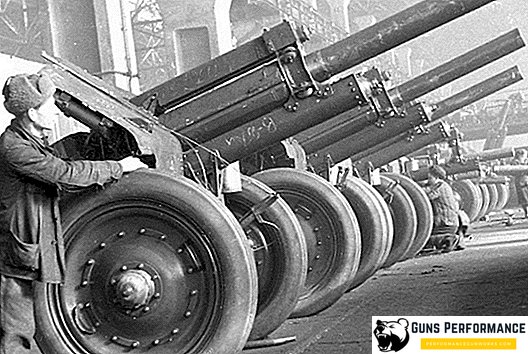
All military propaganda, all shouts, lies and hatred, always come from people who will not go to this war
George Orwell
Why start a war? This question looks somewhat strange: of course, to get a victory and defeat the foe. But what is victory? Complete and total destruction of the enemy? This has also happened more than once in the history of mankind, but harsh genocide is the exception rather than the rule. Most often, the war begins in order to impose his will on the enemy, force him to abandon his own ideology, part of his freedom and force him to do what is necessary for you. Any military conflict is an act of armed violence that pursues purely political and economic goals.
A defeat in a war is a state of one of the parties when it is no longer able to resist and refuses to fight. History knows a lot of examples when the defeated enemy had all the necessary material resources to continue the fighting, but had no moral strength and surrendered to the victor’s mercy. This is the real Victoria. It can be achieved not only with the help of tanks, guns or carpet bombing, but also using more subtle tools aimed at the mind of the enemy. Today, such actions are called information warfare. It can be directed not only at the armed forces of the enemy and the population of an enemy country, but also at the soldiers of his army and his own citizens.
The concept of information warfare appeared only a few decades ago, but in reality this war is as old as our world. Humanity learned to lead it many thousands of years ago. Sometimes this kind of war is also called psychological, and in a broad sense it is a complex of actions aimed at changing the mind of your opponent, introducing into it the installations you need. Information warfare (IW) can be waged either directly in the course of hostilities, or precede them. In wartime, the main task of the executive power is to demoralize the enemy’s army, to break its will to resist, to incline to surrender. Information war is inextricably linked with such a term as propaganda.

History of Information Wars
Information warfare is often the responsibility of various intelligence agencies, although there are special units and organizations that deal with this issue. In the USSR, it was the 7th administration of GlavPUR RKKA, in the Third Reich - the Ministry of Public Education and Propaganda, and in the USA - the Bureau of Information. Professional propagandists first appeared during the First World War.
Methods of information warfare are varied and diverse. The oldest known is bullying the enemy. For example, the Persian king Xerxes I, before invading Greece, through his agents spread rumors about the invincibility of his troops: "... if all the Persian soldiers shoot their bows, then the arrows will eclipse the sun." Misinformation about secret weapons, from which there is no salvation, worked well. So did Genghis Khan and Hannibal. In order to achieve submissiveness of the population of the occupied territories, total terror, bordering on genocide, was often staged against it. Any attempt to resist the invaders was suppressed as bloody and defiant as possible. Through such actions, people were horrified in the hearts of people and forced them to abandon their further struggle. That is what the Mongols used to do.
Another proven method of waging psychological warfare is splitting the enemy’s camp. It is necessary to sow discord among enemies, deprive them of unity, and ideally force them to kill each other. If you are acting against a coalition, then it is necessary to destroy it and beat the enemies one by one.

The main method of IW is disinformation. At different times, she was reported to the enemy in the most bizarre ways - as far as talent and fantasy were enough. A typical way is to drop a scout into an enemy camp. But sometimes they used more interesting options. Having once again defeated the Hungarians, the Mongols seized the personal seal of the Hungarian king and began issuing decrees on his behalf to cease resistance to the invaders. Then they were sent to all parts of Hungary.
The favorite technology of information warfare in the Middle Ages was incitement to insurgency of the feudal nobility of the enemy state.
Given the authority of the church, in the past it was often connected to the conduct of the information war. For example, during the war of 1812, Catholic Napoleon was twice anathematized by the Moscow Orthodox Church, which was announced to Russian nationals. True, between the excommunications, he was awarded the highest award of the empire - the Order of St. Andrew the First Called.
With the advent of typography and the gradual penetration of literacy into the masses in the information war, increasingly began to use the printed word. So began the information war in the media. The leaflet became a typical bearer of propaganda and misinformation, they were delivered to enemy soldiers or people in various ways. On an “industrial” scale, the use of leaflets began during the First World War. In the same period, the main participants in the conflict created special services that were engaged in propaganda.

In general, it should be said that it was World War I that gave an unprecedented impetus to the development of information means of warfare. After the end of this conflict, a significant number of researchers engaged in the development of the theoretical basis of psychological warfare. For the first time, the definition appeared that the goal of the war was not to destroy the enemy’s army, but to undermine the moral state of the entire population of the adversary state to such an extent that it forced its government to capitulate.
Surprisingly, the First World War clearly showed that propaganda must first be directed to its own population and the army. The best propagandists of the WWI were the British. Among other things, they were the first to come up with the idea of creating propaganda shells, agitmin, and even rifle agitgranate.

One of the brilliant technologies of the information war, which the perfidious Anglo-Saxons used against the Germans, was the so-called horror propaganda. In the most famous newspapers they printed completely fake materials about the atrocities and atrocities of the German troops: rape on nuns, executions of priests, and brutal murders of captured British soldiers. A typical example of a fake of that time is the story of a crucified Canadian soldier, so the plot of the Ukrainian media about the assassination attempt on the former journalist Babchenko is a dull plagiarism with some added trash.

The most vile invented history of the time is the English fake that the Germans are processing the corpses of their own and foreign soldiers to feed pigs. He caused a whole storm of indignation around the world: after this news, China joined the Entente, and in England and in America the material caused an unprecedented influx of volunteers who wanted to go to the front. Like, how is it, brothers? Feed the fallen gentlemen pigs ?! Let's asshole these vile Teutons!

It should be noted that the materials were perfectly fabricated - all the facts were confirmed by trained witnesses, and people really believed in them.
The Germans also tried to turn something like this: they told their population that the Russian Cossacks were eating babies (they were again believed). This forced the German soldiers on the front to fight even more heroically in order to protect the Vaterland from the wild Asian cannibals.
There should be one small digression. It is not normal for a mentally healthy person to take the life of his own kind in the name of incomprehensible political interests or abstract ideas. Therefore, the main task of any propagandist is to “unhumanize” the enemy. Like, look: they eat babies or children are crucified on bulletin boards - well, what kind of people are they? Atu them guys! Beat-kill!
The fact is that during the war, the human psyche works a little differently than in normal peacetime. Stress makes the deepest mechanisms of our personality work and clearly divides the world into “our own” and “alien” ones. In many ways, a person loses the ability to critically assess reality and can believe the most ridiculous bikes.
Another direction of the British propaganda of the PRC was to downplay their own losses and exaggerate military achievements. Naturally, the soldiers of the Entente were portrayed in the newspapers as noble and fearless knights.
Led by British propaganda during the First World War, Lord Northcliffe. We can say that this person raised the information war to a whole new level. Today, every literate person knows the name of Hitler’s propaganda minister Goebbels. However, there is no doubt that this evil genius of Hitler had very good teachers and proven methods of turning an average citizen into a murderer and monster.
It cannot be said that Lord Northcliffe discovered something completely new: at all times his own soldiers were portrayed as heroes, and the enemy as murderers and villains. However, the propagandists of the WWI got into their hands a new powerful tool - the media - that could bring the ideas of propagandists to the majority of the population. The British had to work out only the “minor” details: decide to create absolutely trash and completely invented materials, learn how to prepare false witnesses and fabricate photos of their horrors. And put all of the above on the conveyor.
By the way, during the WWI, the Germans did not dare to do this (but they completely won back during the next world war). Later, the future Fuhrer of the Third Reich, Adolf Hitler, in his book Mein Kampf wrote the following: "The more monstrous you lie, the sooner you will be believed. Ordinary people believe more big lies than little ... Big lies will not even come to them. imagine that others were capable of too monstrous lies ... "
During the Second World War, all participants in the conflict gave great importance to the information war. This issue was dealt with by special structures, propaganda was conducted both among its own population and the army, and among the troops and the population of the enemy. A feature of this conflict was an even greater role of the mass media, radio and cinema appeared. To promote disinformation on the territory of Britain, the Germans managed to create even a few fake radio stations, which allegedly were in England and had a broadcasting style similar to English resources. Through them, misinformation was regularly thrown in order to demoralize English society.
The British did the same thing.
More traditional methods of influence were not forgotten either: leaflets or passes for surrender were scattered over the enemy territory and the positions of the troops. Soviet propagandists at the front actively used loudspeakers through which prisoners addressed the German soldiers, calling on their comrades to surrender.
World War II gave birth to its own monstrous fakes. For example, about the industrial production of soap by Germans from the corpses of Jews tortured in concentration camps. This myth still roams from one textbook to another, although its inconsistency was confirmed even by modern Israeli researchers of the Holocaust.

New development of information methods of warfare received in the era of the Cold War. It was a time of collision between two ideological systems: the Western and the Soviet. However, after two world wars, propaganda has changed somewhat. American experts in psychological warfare expressed it this way: "Propaganda is practically only then doomed to failure, if it looks like propaganda."
Americans are very actively and quite successfully used the methods of psychological warfare in Vietnam. The main focus was on demoralization and intimidation of the local population and partisan fighters. During the fighting, they managed to achieve a transition to their side of more than 250 thousand Vietnamese.

The USSR perfected methods of psychological warfare in Afghanistan. A variety of agitation and propaganda events were held, from the distribution of material assistance to the spread of rumors and anecdotes about the leaders of the Mujahideen. However, it should be noted that the Soviet troops in the Afghan war paid much less attention to propaganda than the United States in Vietnam.
Daily life of modern propagandists
At present, modern information technologies have brought psychological war to a completely new level. Computer technology has virtually erased state borders, turning the planet into a single information field. Modern media have such opportunities that the great propagandists of the past simply turn green in hell with envy.

Starting from the first Gulf War, Western countries (and now Russia) can conduct hostilities just live, online. At the same time, modern television is not only capable of giving distorted information, it can create a new reality, very far from reality. The actions of their own troops are served from the most positive angles, the enemy is in every way demonized. The approach has changed little since the First World War, but the toolkit of propagandists was simply fabulously enriched.
Everything is used: “absolutely truthful reports” from the place of the monstrous and mass atrocities of the enemy (with the involvement of carefully selected witnesses, of course), hiding important facts or immersing them in information peels. At the same time, the very quality of the reports is so realistic that it does not raise any questions for the viewer.
One of the main goals of the information war is the achievement of complete domination in the information space. The enemy simply should not be able to convey an alternative point of view. This result is achieved by various means: full control over the media that operate in a combat zone, or by military means. A repeater or television center can be simply bombed, as the Americans did in Yugoslavia.

If we talk about the US information war, then a good example of how the Yankees work will be the first Gulf war. Information that came from the scene of hostilities was clearly controlled. On television, there were no shots of wounded and killed American soldiers or civilians. But a lot of attention was paid to the military victories of the coalition: journalists gladly showed columns of burned Iraqi armored vehicles and a string of captured enemy soldiers.
The first and second Chechen campaigns are a good example where the role of the information war in the modern world can be shown. Informationally, Russia lost the first war in the North Caucasus, which is called “one-way”. That is why this conflict for the majority of Russians is a symbol of shame, betrayal, absolutely senseless victims and suffering, the weakness of the country and the army.
The second Chechen war was covered in the Russian media in a completely different way. The access of journalists to the conflict zone was extremely limited, information was controlled. Any interviews with the separatists came under a hard ban, now the main Russian media broadcast only the point of view of the federal center. As for the visual component of the reports, the footage of the wounded and killed Russian soldiers and burned armored vehicles completely disappeared from it.
The example of the Chechen wars clearly shows the very essence of the information war: it doesn’t matter what is actually happening, the main thing is what kind of picture a man in the street sees on TV.
With no less success, modern media can be used to manipulate one’s own population than the current authoritarian regimes enjoy using. Today there is no need to organize concentration camps for the opposition, to carry out arrests of those who disagree, or to burn books in the squares. To ensure power, it is enough to simply control the mainstream media. As practice shows, this is enough to inspire virtually any installation to society.
Modern information wars are fought not only by states, but also by large corporations, public organizations, religious sects, and even individuals.
In recent decades, various terrorist organizations, especially Muslim ones, have actively joined the information war. ISIS (banned in Russia) very competently uses the Internet to conduct propaganda and recruitment of new members. In addition to the usual agitation (articles, videos, news feed in the right way for themselves), the igilovtsy work very skillfully on social networks, attracting professional psychologists for this work.
How to destroy a state without war
Information wars in the modern world can be waged without direct hostilities. Зачастую население страны, на которую направлена информационная атака, даже и не догадывается об этом. В этом случае цели информационной войны очень просты: привести к смене политического режима в стране или максимально ослабить его. Современная "традиционная" война очень дорога, а информационные способы воздействия - прекрасная ей альтернатива, довольно эффективная и не требующая от агрессора жертв. Повсеместное распространение интернета позволяет современным пропагандистам проникнуть практически в каждый дом.
Основной удар наносится по руководству страны, дискредитируется работа государственных органов, подрывается авторитет власти. Населению демонстрируются факты коррупции (реальные или вымышленные), уголовных преступлений, чем провоцируется рост протестных настроений. Среди граждан государства-жертвы информационной атаки создается атмосфера конфликта, безысходности, происходит активная манипуляция общественным мнением. Еще лучше, если к работе на агрессора удается склонить ряд местных СМИ, в этом случае они становятся "рупором" протестного движения.
Китайский стратег, философ и мыслитель Сунь-Цзы советовал завоевателям следующее: "Разлагайте все хорошее, что имеется в стране противника. Разжигайте ссоры и столкновения среди граждан вражеской стороны".

Обычно подобные атаки сопровождаются работой с частью политической элиты страны, которая начинает сотрудничать с агрессором. Через СМИ и интернет транслируются призывы к демонстрациям, забастовкам и другим акциям неповиновения, которые еще больше расшатывают ситуацию. При этом уличные акции, опять же, правильным образом освещаются в СМИ, прославляя протестантов и показывая в негативном свете проправительственные силы и органы правопорядка.
Проведение такого комплекса действий (в случае его успеха, конечно) приводит к потере управляемости в стране, экономическому спаду, а нередко и к гражданской войне.
Тут есть еще один, более глубокий аспект. Современные СМИ не просто могут приводить к хаосу в государстве и вызывать гражданские конфликты. Сегодня они практически формируют устои современного общества, донося до людей определенные ценности и вызывая отрицание других. Человеку говорится, что правильно, а что нет, что следует считать нормой, а что грубым отклонением от нее. Причем все это делается в настолько легкой и ненавязчивой манере, что пропагандистских приемов просто не видно.












